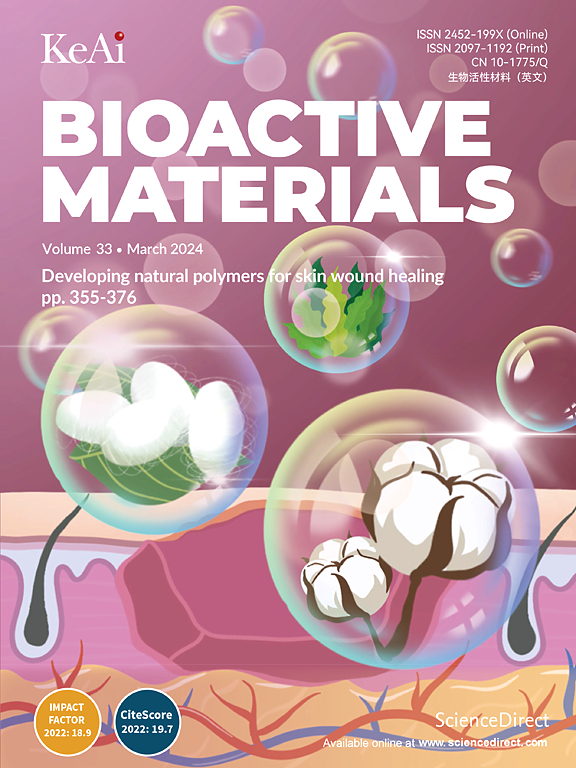一种静电封装策略激发3d打印聚电解质支架修复骨质疏松性骨缺陷。
IF 18
1区 医学
Q1 ENGINEERING, BIOMEDICAL
引用次数: 0
摘要
骨质疏松性骨缺损(OBD)的修复仍然是一个临床挑战,因为骨稳态失调,其特征是成骨功能受损和破骨细胞活性过度。虽然负载药物的3d打印支架在恢复骨骼稳态以增强OBD修复方面具有很大的潜力,但在3d打印支架中实现药物的可控释放和靶向递送仍然是一个有待解决的问题。在此,我们开发了一种静电封装策略,以骨靶向丹酚酸B (sabb - btl)脂质体配方激发3d打印聚电解质支架(APS@P)。得益于这一策略,SAB(一种不稳定且不可靶向的植物源性成骨化合物)被有效地封装在APS@P中,显示出稳定和精确的递送,提高了治疗效果。由于sabb介导的骨稳态,APS@P显著促进血管生成和新骨形成,同时抑制骨吸收,与OBD组相比,骨量显著增加146%,微结构改善。证实将SAB包封APS@P可通过刺激Tph2/Wnt/β-catenin信号轴,刺激H型血管生成,抑制rankl介导的骨吸收,促进MSCs的成骨分化,从而增强OBD修复。本研究为增强组织工程支架的生物活性提供了一个通用平台,为骨质疏松性骨的高效再生提供了有效的解决方案。本文章由计算机程序翻译,如有差异,请以英文原文为准。

An electrostatic encapsulation strategy to motivate 3D-printed polyelectrolyte scaffolds for repair of osteoporotic bone defects
Repair of osteoporotic bone defects (OBD) remains a clinical challenge due to dysregulated bone homeostasis, characterized by impaired osteogenesis and excessive osteoclast activity. While drug-loaded 3D-printed scaffolds hold great potential in the restoration of bone homeostasis for enhanced OBD repair, achieving the controlled release and targeted delivery of drugs in a 3D-printed scaffold is still unmet. Herein, we developed an electrostatic encapsulation strategy to motivate 3D-printed polyelectrolyte scaffolds (APS@P) with bone-targeting liposome formulation of salvianolic acid B (SAB-BTL). Benefiting from this strategy, SAB, an unstable and untargetable plant-derived osteogenic compound, was effectively encapsulated in APS@P, demonstrating stable and precise delivery with improved therapeutic efficacy. Owing to SAB-mediated bone homeostasis, APS@P significantly promoted angiogenesis and new bone formation while suppressing bone resorption, resulting in a significant 146 % increase in bone mass and improved microstructure compared to the OBD group. It was confirmed that the encapsulation of SAB into APS@P could promote the osteogenic differentiation of MSCs by stimulating Tph2/Wnt/β-catenin signaling axis, coupled with the stimulation of type H angiogenesis and the suppression of RANKL-mediate bone resorption, thereby enhance OBD repair. This study provides a universal platform for enhancing the bioactivity of tissue-engineered scaffolds, offering an effective solution for the efficient regeneration of osteoporotic bone.
求助全文
通过发布文献求助,成功后即可免费获取论文全文。
去求助
来源期刊

Bioactive Materials
Biochemistry, Genetics and Molecular Biology-Biotechnology
CiteScore
28.00
自引率
6.30%
发文量
436
审稿时长
20 days
期刊介绍:
Bioactive Materials is a peer-reviewed research publication that focuses on advancements in bioactive materials. The journal accepts research papers, reviews, and rapid communications in the field of next-generation biomaterials that interact with cells, tissues, and organs in various living organisms.
The primary goal of Bioactive Materials is to promote the science and engineering of biomaterials that exhibit adaptiveness to the biological environment. These materials are specifically designed to stimulate or direct appropriate cell and tissue responses or regulate interactions with microorganisms.
The journal covers a wide range of bioactive materials, including those that are engineered or designed in terms of their physical form (e.g. particulate, fiber), topology (e.g. porosity, surface roughness), or dimensions (ranging from macro to nano-scales). Contributions are sought from the following categories of bioactive materials:
Bioactive metals and alloys
Bioactive inorganics: ceramics, glasses, and carbon-based materials
Bioactive polymers and gels
Bioactive materials derived from natural sources
Bioactive composites
These materials find applications in human and veterinary medicine, such as implants, tissue engineering scaffolds, cell/drug/gene carriers, as well as imaging and sensing devices.
 求助内容:
求助内容: 应助结果提醒方式:
应助结果提醒方式:


